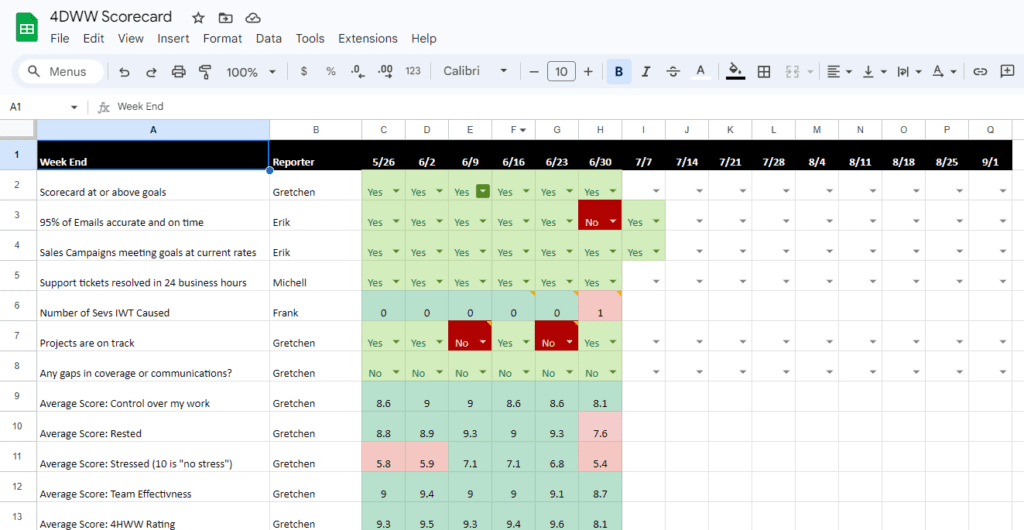
4DWW Challenge: The 5 steps to a 4DWW
This is part of our series on IWT’s 4-Day Workweek Challenge, where we take you behind the scenes to show what it’s like for us as we test out a compressed work schedule. The blog post you’re about to read is written by Tony Ho Tran, a professional journalist for The Daily Beast and a former copywriter for IWT. Join us as we dive deep on the highs and lows of the challenge.
For the past few weeks, we’ve been talking about the benefits of a 4-day workweek (4DWW). You’ve heard stories from Nasrin and Frank about what IWT’s summer-long 4DWW Challenge has done for them.
Today, I want to walk you through exactly how the team got here — and give you steps to get your business to do the same.
After all, the challenge wasn’t a random thing. The company didn’t just decide to try it one day for laughs. It was methodical, systematic, and researched within an inch of its life — which is to say, it was classic IWT.

To get this done, we had 5 steps to get us there. They were:
- Ask the most important question
- Research like a scientist
- Get unwavering buy-in from everyone
- Set crystal clear expectations and targets
- Pitch your boss like a boss
For this issue of the newsletter, I also spoke to two leaders from 4 Day Week Global, a nonprofit 4DWW advocacy group, about best practices on how to pitch your business. They are:
- Dr. Dale Whelehan, the CEO of 4 Day Week Global. Whelehan is a behavior scientist at the helm of the group, using his deep experience in researching fatigue and sleep deprivation in healthcare workers to champion a compressed workweek.
- Dr. Alex Soojung-Kim Pang, the author of “Work Less, Do More: Designing the 4-Day Work Week.” Along with being the global programs director of 4 Day Week Global, he’s written several books on the benefits of 4DWW and how to maximize productivity by doubling down on employee rest and happiness.
Between these experts and IWT’s own experience, you’ll be able to set up the 4DWW for your own business in no time.
Step 1: Ask the most important question
The benefits of a 4DWW are well-researched, and honestly, kind of obvious. If you have one more day to yourself, you’ll be a happier employee — resulting in better work at your job.
Beyond that though, the scientific literature behind it overwhelmingly shows that it’s good for both employees and companies.
But there’s one big question you still need to ask yourself before you even consider pitching a compressed work schedule to your business: Is a 4DWW right for my company — or should I forget it entirely?
“The 4-day week is not a one-size-fits-all approach,” Whelehan tells us, but a flexible policy that can be molded according to your individual needs.
The truth: Not every business should go with a 4DWW. In fact, it’s simply not possible for many kinds of companies.
These might include:
- 24/7 businesses. Businesses that require employees to be present at all hours of the day like customer service centers and transportation companies (taxis, trucking, etc.) have enough staffing issues. While it could work, the idea of implementing a 4DWW might be completely infeasible simply due to lack of resources.
- Emergency services. If you work somewhere like a private ambulance, hospital, or security company, you already know how tough it is to manage the chaotic and long hours of your work. You might have to be on call at different times throughout the week. Plus, people’s lives might literally be at stake.
- Seasonal jobs. Think things like farm and ranch hands, tour guides, and lifeguards. Any work that comes and goes each year will be a poor candidate for a 4DWW because there’s a specific time that things need to be done, and all staff must be on deck to do it. You’ll probably never catch a farmer and his workers taking a day off — let alone 3 days off.
- Jobs with toxic culture. From Pang: “The places where the 4-day week is hardest have cultures that treat long hours as a sign of professional dedication, or that have well-developed pipelines for recruiting talent, working it to death, and replacing it. So don’t expect hedge funds and consulting firms with deep connections to Oxbridge and the Ivy League to move to a 4-day week any time soon; they’re making too much money to change.”
The last point is important. Ask yourself, “Do my company culture and values fit a 4DWW?” If the answer is no, then pitching a change won’t be good for you — and that’s fine if you enjoy the job. If not, don’t worry: We have plenty of resources to help you find a career you’ll love.
For IWT, a 4DWW allows us all to not only live our company values, but also to enjoy what we’ve been championing for years: a Rich Life. It only makes sense that we embrace a 4DWW, because its goals align perfectly with what everyone wants from the job.
“If your company has a strong culture of trust and innovation, then you’re ready to make the transition,” Whelehan says.
However, Pang notes that even if your job falls under any of these categories, there’s still a good chance that you might be able to work it out if your business has the staffing resources and the willingness to go through a few growing pains.
In fact, businesses that do fall into the categories above have done it before — it just might require you to be a little more creative than other companies when scheduling.
“The evidence is clear that it can be adopted by companies of all sizes, in a very wide range of industries, around the world,” Pang says.
Step 2: Research like a scientist
This is the fun part: You’re going to research 4DWW like you’re a genius scientist on the brink of the cure for Sunday morning hangovers after one-too-many drinks at the bar.
That’s to say, you’re going to treat research like a matter of life and death.
It doesn’t matter if you’re trying to convince your boss, or if you are the boss trying to convince your employees. A 4DWW is a HUGE risk no matter who you are.
Put yourself in an average U.S. worker’s shoes. A 5-day 9-to-5 workweek is so ingrained in American culture that any alternative looks like a lazy, money-wasting bunk.
If you fail, that means that the company loses money, you piss off clients and customers, and you end up wasting a lot of everyone’s time. That’s a trifecta recipe for unmitigated disaster — and a pink slip.
“Gather research and evidence from sectors similar to yours, demonstrating where this has worked before, and really emphasize the business benefits,” Whelehan says.
Ready to improve your habits and level up your life? Download our FREE Ultimate Guide To Habits below.
“This isn’t just a calculation,” Pang adds. “It requires a willingness to go against the conventional wisdom, to resist the muscle memory built up through years of professional practice and performative busyness.”
Luckily for IWT, the idea for the 4DWW came from the president of the company herself: Gretchen Leslie.

The idea to test out a 4DWW has been tossed around IWT for years — but it was always “too hard” or “not the right time,” Gretchen says. Being an innovative go-getter who’s always looking for ways to make her co-workers happy and the company productive, she fell headfirst into an ocean of studies, articles, blog posts, case studies, YouTube videos, TikToks, ancient scrolls, and stoic whisperings from wise productivity sages atop mountains about the 4DWW. (Okay, maybe not all of that.)
From this research, she compiled a 9-page meta analysis synthesizing the benefits, drawbacks, and approaches when it came to 4DWW that she got from the dozens of studies and articles that she had read.
This included insights from 28 different articles and scientific papers dedicated to the 4DWW.

While you don’t necessarily need to go this far, the more research you have to make your case, the better it will be for you to convince your co-workers, and eventually, pitch your boss.
Step 3: Get unwavering buy-in from everyone
This is likely the most important step — even more important than pitching your boss.
If you don’t have buy-in from your co-workers, then you’re going to fail. Plain and simple.
This is going to be a MASSIVE change. It’s going to require every person to reframe and relearn everything they thought they knew about work.
It’s also going to require everyone to work together to help make it successful.
“Making the 4-day week work requires everyone in an organization to work together, and effective cooperation requires a shared understanding of what everyone is trying to do, what will define a successful trial, and what could derail it,” Pang says.
The key here: communication. You need to make sure that everyone understands early and often what this project is, what its benefits and drawbacks are, and what success looks like.
This is where all that research you did in the last step comes in. You’ll be able to use any and all information you’ve gathered for any and all questions, like a high school debate nerd. (But remember: It’s not a debate — it’s a conversation.)
Eventually, Gretchen brought the idea and her findings to her leadership team to pitch 4DWW. “If my leadership team would have shut it down, I would have stopped there,” she says. “But they were SO EXCITED that we kept going.”
It wasn’t immediate. The leadership team meticulously went through every question and concern that they possibly had about 4DWW. Once that was done, they compiled their findings before bringing it to the rest of the IWT team.
“When we took it to the whole team we framed it as, ‘We’re going to try this but we need to know what YOU need to make it work,’” she says. “So we were going to try it but we needed to hash out the details as a team on the rules of how we’d make it work. That let us get everyone’s concerns on the table and make sure that everyone had a voice in the process.”
Step 4: Set crystal clear expectations and targets
We’re really into SMART goal setting at IWT. Without clear and defined benchmarks for success, you end up spinning your wheels and going nowhere.
The same goes for the 4DWW.
“Your number one priority should be strong communication,” Whelehan says. “Everyone must have a clear understanding of how the transition will work, what’s expected of them, and what to expect from their employer. Clearly defining what success will look like from the outset is key.”
Defining what your goal is can be hard — especially with a big hairy audacious goal like a 4DWW. That’s why both Whelehan and Pang recommend that companies do a trial period before making the full jump.
Why? Simple: It allows you to do a 4DWW without the fear of long-term disaster.
Scary questions like “What if it all goes wrong?” or “What if we lose all our customers?” immediately dissipate into thin air because it can be temporary.
For IWT, it is going to be a summer-long test. That’s just enough time to get a feel for whether or not a 4DWW works — or if everyone should just abandon it entirely.
The team at IWT took it a step further and mandated regular check-ins with each employee to gauge how everything is going. If anyone ever feels like it’s not working out, the team can come together, discuss what’s wrong, and fix the matter.

Gretchen also compiled yet another 4-page document detailing exactly how IWT will go through its own 4DWW. This included:
- Success criteria. No increase in management emergencies, the average workweek is around 33 hours per week, and no drops in performance.
- Length of trial. The 4DWW Challenge runs from May 22 and Sept 1.
- Employee requirements and expectations. Each person chooses their days off, is available for certain team meetings when they are working, and absolutely no Slack or email on their rest days.
- Reasons for testing 4DWW. This is sneakily crucial. This section walked through each of IWT’s values and showed how they align with having a compressed work schedule. Not only does this make a strong case for living the company’s values, but it also shows how it’s in the best interest of IWT’s culture and bottom line to do so.
This document does two brilliant jobs. First, it is a great reference for any employee who might have questions about the 4DWW. However, it also is a fantastic pitch document for co-workers and your boss.
Step 5: Pitch your boss like a boss
This might seem like the scariest part — and truthfully, it can be very nerve-wracking.
BUT if you did your homework, and can show that the rest of the company is bought into the 4DWW, then this step might actually be the easiest one of them all.
The reason: You’ll show how a 4DWW saves the company, its employees, and your boss time — AND it’ll generate more productivity, efficiency, and (therefore) revenue as a result.

“It’s normal for them to have reservations and the key to success is how well you address them,” Whelehan says. “Anticipate their concerns and prepare your responses accordingly. Treat their worries seriously, and if necessary, go away and take some time to really delve into how you could successfully navigate them.”
Pang adds that it’s also important to make your boss feel like they have a hand in this too. Let’s be honest: Bosses LOVE when they feel like a good idea is their own.
Frame the idea so it shows that they have a ton of input as well. Any success that the company experiences is directly tied to their decisions.
“The key is to make clear that this can’t happen without them, and that they won’t make the jump alone,” Pang explains. “They’ll be leading a group that will fulfill the leader’s vision, and reward their trust. Leave white space in the plan, so they can help shape it, and in turn, feel invested in it.”
It’s the same key to negotiating anything with your boss: You have to know what they want. Pitch to them like you were in their shoes.
That was a lot — but with these steps and the tactics provided by Whelehan and Pang (not to mention IWT’s resident BAMF Gretchen), you’ll be well on your way to winning over your entire company in testing out a 4DWW.



